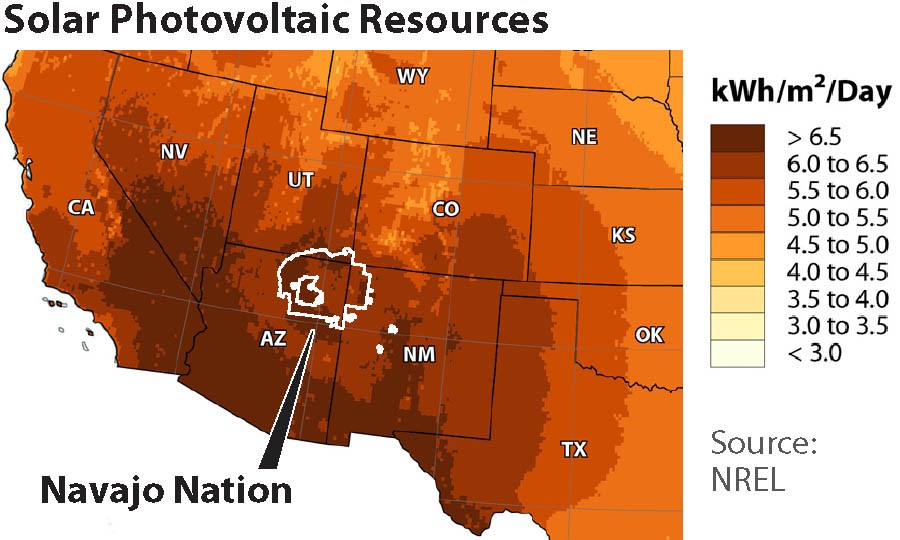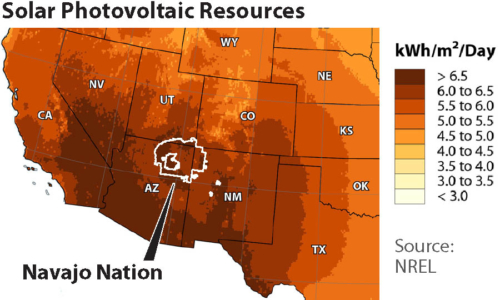IEEFA U.S.: Solar tax credit extension through 2024 critical for coalfield communities

(IEEFA U.S.) — The federal solar tax credit should be extended by at least four years in coalfield areas, like the ones around the Navajo Generating Station (NGS) and Kayenta Coal Mine in Arizona, according to a briefing note released today by the Institute for Energy Economics and Financial Analysis (IEEFA).
“Scheduled curtailment of the tax credit comes at the worst possible moment for vulnerable communities that are facing impending closure of a power plant or a coal mine that provides revenues critical for government services,” said Tony Skrelunas, Navajo, MBA, lead author of the brief and a former director of economic development for the Navajo Nation.
As it stands, the tax credit, which was created in 2005 and renewed by Congress four years ago, will be stepped down annually — from 30% currently to 10% by 2022. The credit is seen as a crucial catalyst to the still-nascent solar industry, which has yet to arrive full force in most communities that are being hit hard by the rapid descent of the coal-fired electricity-generation sector.
A ‘modest policy change’ to restore lost tax revenue and create jobs
The briefing note — Extending the Full Federal Solar Tax Credit by Four Years (Through 2024) for Coalfield Communities — highlights that Hopi and Navajo communities will be sorely hurt by the closure this year of NGS. The Hopi tribal government will lose 80% of its revenue from the closure, and the Navajo government will lose about one-third of its revenue.
The IEEFA brief recommends accelerating efforts to build a regional utility-scale solar industry to help replace some of the lost tax revenue, a move that would be critical for creating jobs as well.
 In addition, the brief emphasizes that the issue is not restricted to tribal lands. Many coalfield communities nationally — in Appalachia, the Powder River Basin of Montana and Wyoming, in New Mexico and elsewhere in Arizona — are also struggling as coal plants and mines are retired or shut down.
In addition, the brief emphasizes that the issue is not restricted to tribal lands. Many coalfield communities nationally — in Appalachia, the Powder River Basin of Montana and Wyoming, in New Mexico and elsewhere in Arizona — are also struggling as coal plants and mines are retired or shut down.
“Such an extension would support economic development in these areas, and it would be especially helpful if it were to give priority to communities that don’t have enough time to effectively respond to impending plant and/or mine closures,” Skrelunas said. “For tribal lands, we also recommend a special federal policy provision that that would allows tribes to partner with experienced developers in a way that maximizes monetization of the value of the tax credit.”
Excerpts from the IEEFA brief:
- “A four-year extension, through 2024, of the federal tax credit on Hopi and Navajo tribal lands — and across coalfield communities nationally — would likely bring local and regional benefits by driving new utility-scale solar projects on sites like NGS and its companion Kayenta Mine, both of which are to be closed this year. Utility-scale solar can help replace lost jobs, and the tax revenues it generates can help local economies during the transition.”
- “Utility-scale solar projects do not exist yet in most of these areas, despite the surge in such project development across the U.S., in general. A tax-credit extension carve-out could help to bring solar industry expansion to the very communities that can benefit most from it.”
- “An adequate carve-out would require a congressionally-approved extension that would keep the full federal solar tax credit in place longer for communities that are being economically devastated by shutdowns of coal-fired plants and coal mines. Hopi and Navajo tribal lands are a showcase example of where such an extension could help sustain a struggling local economy.”
Full brief: Extending the Full Federal Solar Tax Credit by Four Years (Through 2024) for Coalfield Communities
Author contacts
Tony Skrelunas (Arizona) [email protected] +1 (928) 853-0048
Karl Cates (New Mexico) [email protected] +1 (917) 439-8225
Media contact
Vivienne Heston ([email protected]) +1 (914) 439-8921
About IEEFA
The Institute for Energy Economics and Financial Analysis (IEEFA) conducts global research and analyses on financial and economic issues related to energy and the environment. The Institute’s mission is to accelerate the transition to a diverse, sustainable and profitable energy economy.










